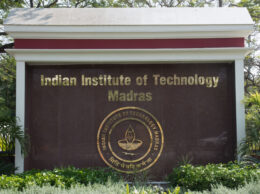CHENNAI : Indian Institute of Technology Madras Pravartak Technologies Foundation is partnering with Asha For Education to launch Rural Technology Centres to take computer science literacy to remote and rural Government School Students in Tamil Nadu.
Two Asha-IIT Madras Pravartak Rural Technology Centres were inaugurated today (11th February 2022) at Kanakamma Chathram and Seethanjeri Villages of Tiruvallur District, located about 60 km from Chennai. There are plans to launch more such Rural Technology Centres near Government Schools this year.
A video byte of Ms. K. Barkavi and Ms. A. Kokila, Students, Government Higher Secondary School, Kanakamma Chathiram, Tiruvallur, sharing their experience can be viewed and downloaded from the following link – https://drive.google.com/file/d/1FM7Vik9xtxiV7nnboqGT8Xk8dY5Nl_U6/view
These Centres will spread the knowledge of technology and its benefits to rural areas of Tamil Nadu. The Centres will train students of Classes 9 to 12. IIT Madras Pravartak Technologies Foundation is providing financial support for this project with technical support being envisaged as well.
Highlighting the key objectives of Asha-IIT Madras Pravartak Rural Technology Centres and its benefits to rural students, Prof. V. Kamakoti, Director, IIT Madras and IIT Madras Pravartak Technologies Foundation, said, “IIT Madras is committed to working towards providing access to quality education and technology to students belonging to rural areas of our Country. The setting up of these two rural technology centres mark the beginning of our journey.”
Asha for Education is a worldwide action group formed to catalyse socio-economic change in India through the education of underprivileged children. It has been working with Elementary and Middle Schools since 2015 to educate students in both digital literacy and computational thinking. The group uses advanced block-based programming tools such as ‘Scratch’ from Massachusetts Institute of Technology (MIT) and ‘Blockly’ from Google to teach programming.
Speaking about their training initiatives for school students, Mr. Rajaraman Krishnan from Asha For Education said, “These tools are so easy to use that the Middle School students have mastered these in a few weeks and shown tremendous enthusiasm in learning. Asha expects to build on this expertise by using proven methodologies like the curriculum from ‘code.org’ that have been used and tested in other countries successfully. We also intend to use IIT’s experience and expertise in quality technical education.”
Further, Mr. Rajaraman Krishnan said, “We wanted to open the centres close to higher secondary schools so that the students will be able to attend courses in our centres in the evening after their school hours. Most children do not get any opportunity to learn computer science and other technologies. Even if they do it is taught without any hands-on experience with computers. We hope to provide these with our rural technology centres.”
The Key Outcomes envisaged from this include
⮚ Use new technologies without any fear and with confidence.
⮚ Provide the children a space where they can experience new technologies with instruction and guidance from teachers.
⮚ Develop their computational thinking and design thinking skills which will help them in all their other endeavours.
⮚ Provide them an opportunity to express and enhance their creativity by involving them in interesting projects.
Elaborating on project, Ms. R. Divya, a teacher from Asha For Education who works at the Rural Technology Centre in Seethanjeri, Tiruvallur District, said, “The Rural Technology Centres are a great opportunity for rural students to learn computers. The students are eager and showing a lot of interest. We hope more such centres will be opened.”
Speaking about the benefits of this program, Mr. T. Gunasekar, Headmaster, Government Higher Secondary School, Kanakamma Chathiram, Tiruvallur District, said, “This school is located in rural area that mainly educates students from weaker sections. This initiative to educate students on computers is of great benefit.”
Mr. K.G. Muralidhar, Headmaster, Government Higher Secondary School, Seethanjeri, Tiruvallur District, said, “This free training program in computer science being offered through Rural Technology Centre will help students develop their knowledge of computers. We hope this initiative will be expanded to reach more students.”
STUDENTS EXPERIENCES:
Ms. K. Barkavi, a student of Class 9, Government Higher Secondary School, Kanakamma Chathiram, Tiruvallur District, said, “We used to study computers earlier in our middle school. We missed the learnings and lost touch. Now, we are able to again learn computers.”
Ms. R. Kavitha, a student of Class 10, Government Higher Secondary School, Kanakamma Chathiram, Tiruvallur District, said, “We were eager from a very young age to learn about computers but never had the chance to do so till now. This Centre is helping us learn about computers. We are having lots of new experiences through these laptops.”
Ms. A. Kokila, a student of Class 10, Government Higher Secondary School, Kanakamma Chathiram, Tiruvallur District, said, “The computer classes are helping us to regain the lost classes and learn new things as well.”
Ms. B. Kavya, a student of Class 10, Government Higher Secondary School, Kanakamma Chathiram, Tiruvallur District, said, “We are able to learn a lot of new things through these classes.”
- Aarthi, a student of Class 11, Government Higher Secondary School, Seethanjeri, Tiruvallur District, said,“I always wanted to learn computers but had no one to teach at home. These computer centres are helping us learn and benefitting all of us.”
Based on the assessment of students’ levels, the Asha Team is planning to start two courses on Basic Digital Literacy and Basics of Programming. While instructions will be provided for two-thirds of the course, one-third of the course will be left for project work where the children create a presentation or software program of their own.
These two basic courses will be followed up with other Code.org courses on Animation, webpage design, and hardware based programming, among others. We will also eventually bring in more advanced technologies like drones, 3-D printing, robotics, and Artificial Intelligence, among others, to the children.









